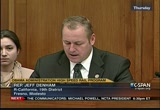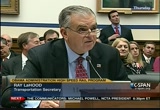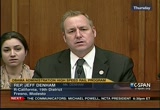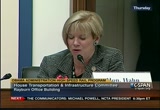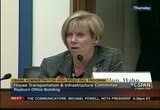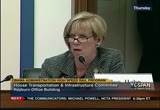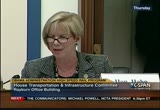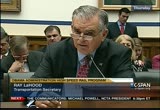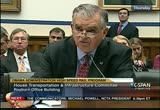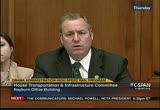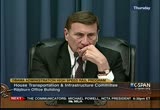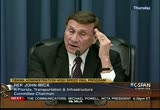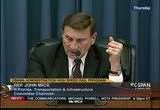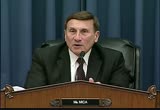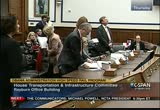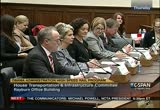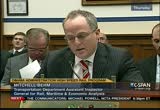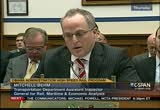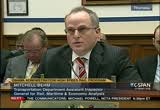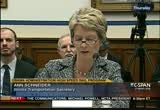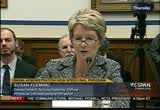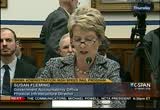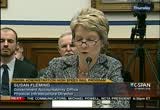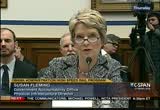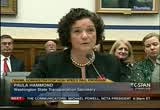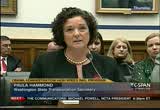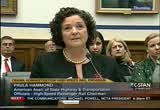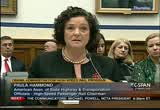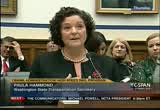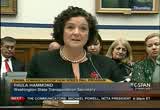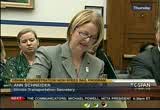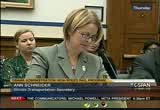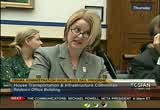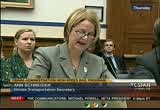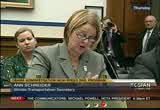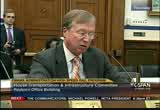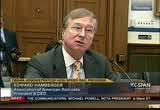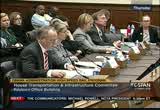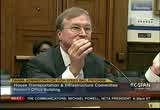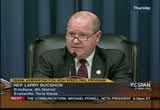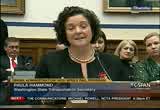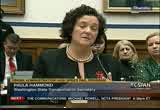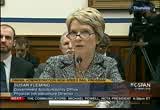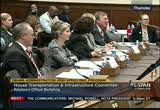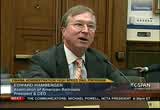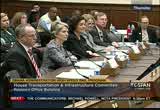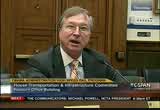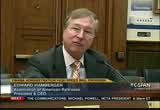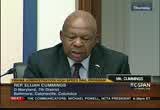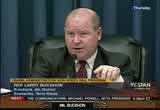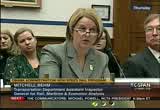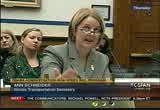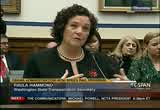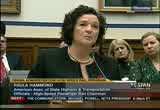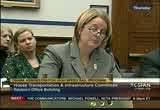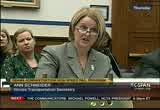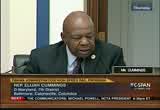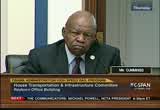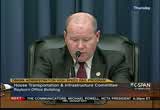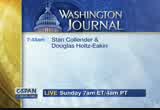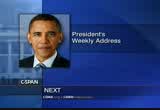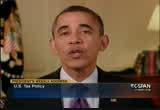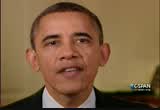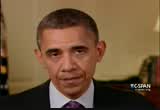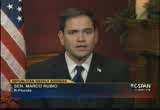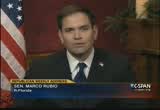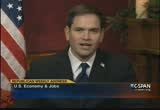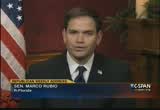tv High- Speed Rail CSPAN December 8, 2012 5:00pm-6:30pm EST
5:00 pm
changes. the numbers i have would be 28 some of the project. the unfunded peace, $38.6 billion that was unsecured federal funds, 68.4%. you anticipate that will be a request from congress on stimulus dollars. any idea>> i will be honest wit. i would hope that we could find members of congress that would not prohibit the federal government's from funding high- speed rail projects. that is a good first start. as long as there is language and bills that prohibit us from funding, we are going nowhere.
5:01 pm
so if you'd be good enough to withdraw your language in the appropriation bill or tell mr. mccarthy to do that, that would be a good first start for us. we are not going to get $1 as long as there is a long voyage -- language in the appropriation bills that says no federal money can be spent on california high- speed rail. that does not help us. that does not help but get any more product -- money to the project. that is why i say we are looking for private investment. >> amendments are not meant to help you. they are meant to stop this product until we see a plan terry we have been talking about this for two years. but something i can bring back to my state, my district and say this is the plan. like the last time we talked about it, i suggested he said that with mr. dan richard and go over the plan and review it. i would be happy to have mr. iraq -- mr. richard sit down with you and review what the
5:02 pm
plan is. if he does that, would you withdraw your language? >> when you can jammeh this project is fully funded and we have a private investor -- when you can show me this product is fully funded and we have a private investor. i have been hearing this story for many years. in the first came up in thought of the state senate, it was if he does support this, we will have a private investor before it goes to the ballot. we does have to show the legislation supports it. there was no private investor. then they said wait a minute, if we -- if the voters pass it, then we will have a private investor for sure because people short -- show the state is found in the private investor. still no private investor. then they said if he does get the stimulus dollars, we will definitely have a private investor.
5:03 pm
and it became a $98 billion project that would take an extra decade. debbie said egregious have the two numbers, a private investor welcome. i keep hearing about all these private investors -- then we said if we have true numbers, i private investigator welcome. -- will come. i keep hearing about all these private investors. is it $36 billion? let's see how that makes sense. i'm a businessman, too. i run a company. i know that i cannot go out there and borrow money or expand my business or go to sell any product until i have a business plan. to sell to investors. you are trying to sell me on a plan so i cannot put any more amendment out there. i just want to see the numbers. i think the state dollars need
5:04 pm
to see plan as well. i yield back. >> welcome to our panel. you're recognized. >> thank you. let me go on record saying i totally 100% agree with the idea of extending the green line into los angeles international airport. there is no other international airport in the world that does not have a good transportation system that goes directly into a terminal. the thought that people stop a mile short and try to get on the shuttle and get to the airport is a reason people are not taking public transportation. i will no longer be able to stop all the products until they get that done. just torpedoed a few.
5:05 pm
>> i am with you on that. mr. denham, i hear your comments about the possibility of leaving -- and i do remember our legislature falling all over themselves to waive that when it came through building a football stadium in los angeles. i think the conversation is one we should have. if there is any way it would soften your stance of our california high-speed rail, i will be the first one to start that conversation. i think that is something we should have. mr. secretary, it is great for me to sit here and listen to your passion and vision in what a high-speed rail would beam, not just to california but to this country.
5:06 pm
i know you have a lot of concerns about this. although i do believe you were in the legislature in 2009 and on a letter you wrote to secretary lahood asking for stimulus dollars to be given to california. but i voted on it. i was fooled at one time. now we are trying to fix that situation. rex that is okay. you have a whole, the vision at that time. i think we should get back to that. i hope there comes a day when our california delegation will be in support of been the model for this country and making sure that the federal government invests in it. secretary, you have talked about this new product we are going to be building, the real cars in illinois. -- the rail cars in illinois.
5:07 pm
even if it is a somewhat unconstructive vision that we have of high-speed rail in california. i hope to be one of the champions here in congress to continue to urge us to build a high-speed rail and the california. it would be a proud moment for this generation. what are we going to build that is great and significant and has incredible impact for jobs, the economy, and the future of transportation for tourism? in los angeles, tourism [unintelligible] we want tourist dollars and a california. those of the dollars that matter to us. the only thing i will ask is, there is always a bureaucracy that has to implement the plans,
5:08 pm
the progress, the process. can you tell me, secretary lahood, how has the california high speed rail authority been in working with your department? had it been open, responsive? is this a good agency as we move forward to build this project? let stand richard is an extraordinarily gifted chairman -- >> dan richard is an extraordinarily gifted chairman. he's knowledgeable about how to get things done in california. appointees ares very dedicated people. i had been impressed with the board. jeff morales is also a gifted individual and committed to doing this the right way and
5:09 pm
working with all the stakeholders in california. i think the right people are really in place right now. i would not have said that a couple years ago. i will tell you this, on a trip i made to california, i spent three days along the corridor. primarily in fresno but the central debt -- central valley. i was stunned at the way the court treated. by the previous people that were in place. treated very shabbily. very arrogantly. dan was in that meeting. we made a commitment to these farmers and met with some small business people in fresno who had also been treated shabbily. i do not blame them for being against this project. we told them we would make a right for them. we are trying to work with these people who spent their whole lives in agriculture, whose farms had been in their families for 100 years.
5:10 pm
who have been treated very shabbily by people in government. we made a commitment. i think dan has followed through on that. i experience a hard feelings. i do not know of some of those are your constituents are not but i know this, these people in california were not treated right. i do not blame them one bit for feeling the way they do about this project. we have to get them back. we are working on doing that. i do not know if we will or not but we will work on it. we need to do better when it comes to the people along this corridor. i would say you are 100% correct. when this was sold to the voters of california, when it was a proposition, they did a very good job of doing a lot of our reach to farmers throughout the central valley and getting support for the product at the time. then there were changes that happened with in the authority.
5:11 pm
dewitt out and burned a lot of those bridges, lost in those relationships. -- they went out and burned a lot of those bridges, lost his those relationships. i look forward to a keating with your office. -- engaging with your office. he would have a hard time gaining my support of the cannot rectify things for those farmers that feel like they are going to lose their farms in this process. i yield back. >> thank you for letting me be part of this committee. i am is supporter of high-speed rail. i look forward to working with my colleague in california. i think not only can we get over all the obstacles to beat -- to build the high-speed rail, there is a possibility we will get support for this project. >> in conclusion, let me clear of one thing for the record. there is a lot of confusion
5:12 pm
about where i stood and others stood. it was 84 miles. the administration came forward with a new $1.4 billion offer. it was initially rejected. to try to make an incredibly substantial commitment, the secretary came back with close to $2.4 billion. i try to work with all the parties. first it would not work. but the secretary did go to every extent. the problem was, it was not a high-speed rail project. it was an important inner-city passenger way. i tried to negotiate with the
5:13 pm
governor and others. there were other interests in the state that wanted to go all the way to tampa. the governor review did. there were concerns about the length of the tourist area to tampa. it is a no-brainer. it should be built, it can be built. it could be self sustaining. it can be a great product. but connected the compromise to build it in phases. there are only two left in the united states now. the secretary and i did all we could in our power to make that happen and it did not happen. the money did come back. i was pleased a good portion of it did go into the northeast corridor. we cannot do that piecemeal. we need to do it and get it done not in 30 years but a
5:14 pm
fraction of that time. we can make it happen. one reason i came back is to get that done. we will figure out a way. a multibillion-dollar project in california, and will not be a dog. we want success. we need a plan. we will work with folks. we need to expedite it. then we need to see it is connected. the will work together. i thank the secretary for his cooperation and commitment. i've enjoyed our working relationship. the hour you got a call you were going to be transportation secretary to today. congratulations. they say that stimulation is
5:15 pm
good for the heart. we wish him many more prosperous and healthy birthdays. >> thank you all very much. >> we will excuse the secretary to reflect the final panel in the transportation committee hearing on the high-speed rail program. panelists include the transportation department's inspector general, representatives from the general accounting office and state transportation officials. this is an hour. >> mr. mitchell, the u.s. department of transportation. second witness is susan fleming, director of physical temperature government accountability office. we are privileged to have as a witness paula hammond, washington state chair.
5:16 pm
and a light leader sheikh -- leadership group. then mr. edward hamberger. and ann schneider. i like to welcome all of the. we appreciate your patience. we have had some lively discussion today. there is a lot of interest in passenger rail service inner- city and high speed. we look forward to your contribution. if you have a lengthy statement that extends beyond five minutes, without objection it will all be considered as part of the record and included in the record. we welcome you. we will now begin and we will start with mitchell behm, the
5:17 pm
inspector general for rail maritime economic analysis at the department of transportation. >> mr. chairman, members of the committee, thank you for inviting me to testify in the implementation of the nation's high-speed intercity passenger rail program. since we raised concerns in 2010 about fra's ability to meet this challenge, we have seen them make no progress in implementing the program. it is only dispersed through 8% of the funds. due to challenges in completing component of the former as the holder agreements. my testimony will focus on the challenges. to establish a sound foundation for a primer, fra develop procedures for grant solicitation, administration, oversight and close out. however, fra has not developed
5:18 pm
guidance on how to comply with these policies and procedures. through our survey of staff, we learned grantees did not always meet the rent obligation requirement. nine of 12 grantees indicated that fra could provide more guidance to help them develop acquired documentation. providing guidance on how did not -- complicates the process could help fra prevent miss management and project delays. fra has a status were it rips does not establish time lines for completion./ it lacks clear performance goals. the goal to improve reliability, spee and frequency of real passenger service as i include measures that indicate progress such as anticipated trip time
5:19 pm
improvements, additional trains. a lack of specific performance measures and inconsistencies across documents make it difficult for grant managers, decisionmakers, and other stakeholders to measure progress and identify risks. fra needs to develop a training program. one that incorporates its program policies and procedures to ensure its staff to administer funds across all active grant programs. to help fill the training gap, they have acquired staff to attend training on grant monitoring and applicant out weeds. however, they have not required staff to recognize common fraud schemes such as conflict of interest or false statements, claims, and certification. historically, large-scale plant projects -- grant products
5:20 pm
have been vulnerable to these types of fraud. fra expects to complete curriculum by the end of this calendar year. austan colder agreements need to be completed for fra -- prior to obligation, fra a short grantees completed service outcome agreement. the outline the benefits that will result from the emperor structure investments. while they advocated the funds within the mandated deadline, other required agreements related to maintenance and construction were not complete. the deadline for extending the fund's in completing extra actions -- construction is december 2013. for products with maintenance and construction agreement that remain outstanding, the timeline for completion becomes even more impressed. short term projects have also
5:21 pm
been the late. fra plan of the bidding bonds to these projects by september 2010. but not complete until september 2011 -- but did not complete until september 2011. stakeholder agreement requirements were completed on the case by case basis instead of providing guidance for completing these agreements. grantees reported that without this written guidance, they had difficulty understanding and expectations regarding the terms of the stakeholder agreement. buntsolders' also noted abdicated their ability to fund and complete their short-term project. we will continue to monitor guidance, establishing clear goals and measures and completing comprehensive training. all actions we have recommended as well as other areas we identified as critical to ensuring fra' successful
5:22 pm
internet -- implementation of a high-speed rail program carried -- progra,. >> thank you. mr. fleming, you're recognized for five minutes. texting given the opportunity to discuss the high-speed intercity passenger rail program. the program was established to provide grants to states and others to develop high-speed intercity passenger rail corridors and products. as of november, almost $10 billion has been obligated for 150 projects. products range from multi- billion high-speed -- high-speed rail systems to smaller projects designed to improve speed, frequently, reliability of conventional rail service. my testimony will discuss your ongoing review of the california projects. i am providing our preliminary observations on our work to date. i will also highlight some of
5:23 pm
our key challenges facing this project. first, based on our ongoing review, we have found a hot -- california high-speed rail authority cost estimate exhibits strength and weaknesses. be evaluated cost estimate according to gao's cost guide which provide a best practices for developing reliable cost estimates. the group to these practices into four characteristics. whether an estimate as comprehensive, accurate, well documented, and credible. based on our experience, a hearing to these practices helped reduce the risk of cost overruns, missed deadlines and unmet performance targets. the found the real authority produced a comprehensive cost estimates, including most project life cycle costs, however, they are not based on the complete set of assumptions.
5:24 pm
the cost estimates are also accurate and based on the most recent project scope, including inflation adjustment and contained few mathematical errors. with documentation, and both methodologies are well documented but it does some cases, we were not able to trace the cost estimate back to the source documentation. the also could not verify how certain costs components captivated. having complete documentation is important -- components were calculated. having complete documentation is important. in regards to the cost estimates credibility, the real authority did conduct a sensitivity analysis and independent cost analysis -- analysis but they were limited. it did not conduct risk and uncertainty analysis to determine the likelihood the
5:25 pm
estimates would be met. without these steps, decision makers cannot identify the risk that may affect the project's cost. moving on to my second point, in addition to developing the bible costs estimates, the california high-speed rail project faces many challenges. chief among these is obtaining project funding beyond the initial 130 mile stretch and segment. the real authority has secured $11.5 billion from federal and state sources. it needs at least $57 billion in additional funding to complete the project. as with any large public infrastructure projects, it is relying on public funding. about 81% for the total construction cost. the remaining finance is expected to come from unidentified private investment once the system is operational. as a result of this financing challenge, the real authority is taking its approach, building segments as financing is available.
5:26 pm
given that i speak inner city passenger rail brett program has not received funding for the last two years and featured bonding proposals about federal funding will likely be met with some concern, the largest block of expected bonds is completed for completing the project is tentative. the real authority will face the challenge of developing reliable writer ship. these forecasts are important to assess the plan into viability of the project. factors such as limited data and permission early in private make developing such forecasts difficult. research on ryder ship and revenue forecast for real projects worldwide have shown that writers of forecasts are often over estimated and is likely to be lower than forecast. among other challenges facing the project are potential legal
5:27 pm
challenges associated with state and federal environmental laws and acquiring necessary right- of-way acquisition. this concludes my statement. i would be pleased to answer any questions you and other members of the committee might have. >> thank you secretary of transportation from washington, 5 minutes. >> thank you. this is an important hearing to think about not only lessons learned through the development and implementation of a high- speed rail program but looking forward to reauthorization. states responsible for delivering an operating the real systems in our state are committed to continue a real program of this time. passenger rail has been in place since 1994 we have partnered from the state level with
5:28 pm
amtrak and in our state in a collaborative approach to an incremental delivery of high and higher speed real programs and service. we see the implementation of a national vision as an important part of what we are trying to deliver. we have a corridor between eugene, oregon, and vancouver, british columbia. we have achieved in the last year up to 880,000 passengers and our growth is increasing year over year. we have invested over former to $80 million in the capital and operations and amtrak cascade which is what we call our program. it was not until the recovery act came that we were able to make significant capital and press structure improvement on the rail itself, pink, double
5:29 pm
tracking. all those amenities double benefit high and higher speed rail and more frequent service for passenger rail also has ancillary benefits to our freight rail a in our state. we are very trade dependent and one of the things we are careful about in not only updating our passenger rail program and plan for the feature is to look at both freight and passenger rail movements and how we can coexist in the same corridor together. that is our plant. we have received $800 million of the high-speed rail program money. we have five projects currently under construction with another of five coming in the next year. the improvement, while they bring important investment in our ability to increase our service also have created jobs. more than 2300 jobs will be created in just the capital and
5:30 pm
for structure and indirect benefits. what we are looking for is the long-term stable, troubled choice, for passenger rail in our corridor. our states are growing we cannot build enough lanes on highway states nor do we want to provide passenger service. we want trains, commuter rail, light rail and an integrated transportation system for the 21st century that our citizens deserve. we need to ensure their taxpayer dollars are well spent. we have had a positive experience with high-speed real implementation. we recognize the federal rail moving into the grant delivery agency. we have had some challenges. they are dedicated people.
5:31 pm
i believe they will continue to do well and excel in this program. we do need the written guidance from federal rail administration that helps us know what is coming and what it's expected of us that can streamline the delivery of the program as it moves forward. we also believe that the benefits that have been made in the reauthorization, the more we can streamline and coordinate things like nepa, environmental permitting, so that all the federal agencies can serve as a one dot agency and streamline and find the processes and environmental document can be concurrently delivered and accepted from one agency to another. federal highway administration has been in this business for a long time to read the are good at it. we have found some efficiencies
5:32 pm
in streamlining. i think we can expand that to federal real administration and continue to have great success. the other issue we have had is needing consistent guidance from federal rail. we wholeheartedly agree with encouraged by america, manufacturing in the united states. we are in a transitional period. we have had challenges try to get river -- waivers for as much as five months on a cliff for a real-time that probably should not have taken that time. figuring out how to accommodate the call and find a way to get there in a tradition period would be good. i with suggest that as we move to pira, we would love to see this program continue. there are prior to these and based investments that should and could be made.
5:33 pm
performance based investments are the way of that feature. we are committed to it. we think taxpayers should continue to see the benefits for the dollars invested. we also believe passenger rail as where it is at. we appreciate the vision of the president and the administration. thank you. >> miss schneider, five minutes. >> thank you, mr. chairman, and members of that committee. i appreciate the opportunity to submit testimony on behalf of the illinois governor to give you an update on the high speed in inner-city passenger rail program. i want to thank the members of this committee, the congress, and the obama administration for supporting a help the inner city passenger rail system and for supporting improved service with words and money. we are grateful for the investments from the american recovery and investment act which have provided more than
5:34 pm
$1.4 billion for illinois high- speed rail. these current investments in illinois high-speed passenger rail systems are already supporting thousands of jobs with much more on the way. we cannot do it without federal help. we need continued federal funding for high-speed rail to finish the job restarted and keep our promises to travelers and taxpayers. we ask that congress appropriate additional funds for state making these investments, including illinois in the midwest. neither illinois or the midwest would be the transportation hub of the nation that it is today and the state's diverse economic base would not exist as we know it. illinois was made the center of
5:35 pm
national rail development and today, it hosts a 7,300 mile rail network that serves as a keystone in moving passengers and freight across the state, reaching, and nation. passenger rail service is crucial to the lloyd's transportation network -- illinois' transportation network and has never been more important as today. recordrains carried a 2.2 million passengers last year. ridership is up more than 76 percent since 2006. on the chicago to st. louis corridor, passengers have increased by 22024% since 2006. this increase and that the public demand is why we were proud to debate -- a new high- speed service in october.
5:36 pm
with secretary lahood and governor clinton on the train. by thanksgiving, we began delivering that same 110 mph to regular amtrak passengers every day. inner-city passenger rail is already stimulating development on the corridor and in cities like normal breast tissue has attracted $200 million in related private investment. we have creatred 250 news jobs in rochelle where rail cars are being built. i witnessed caltrans giving the manufacturer of the notice to proceed. collaboration began in 1980 and gained traction in the 1990's whena 10 state initiative
5:37 pm
prepared a plan estate development for high-speed rail to upgrade existing track and passenger rail frequencies and use new technologies to enable faster, safer passenger trains on all of our existing rail corridors. with years of solid planning in place, illinois and its midwest partners were ready to move quickly on april 16 in 2009 when president obama called for a national network that connected high-speed rail corridors. secretary lahood earlier compared the president's vision to the 1950's blueprint for building the u.s. interstate highway system. the federal railroad administration reported illinois $1.2 billion in january 2010 to upgrade service between dwight and east st. louis. the government illinois in full partner with his commitment of $400 million in state funds for high-speed rail from his $31
5:38 pm
billion capital program. federal awards also provided funding to construct a key rail flyover in the englewood neighborhood of chicago's south side to improve mobility. and for the chicago detroit corridor, the next expected route. illinois has a vested $200,00 in that route in cooperation with michigan and indiana. work is progressing to provide needed training which will enable high-speed service to commence in that corridor. we see travel time of an hour. illinois is moving quickly on a high-speed vision, and vision the governor is passionate about and shares with president obama as a key component of a world- class national rural -- rail
5:39 pm
system. and to be federal funding and support for this vision of a national high-speed service has never been more critical than it is right now. thank you for the opportunity to testify. >> thank you for your testimony. mr. edward hamberger, you have five minutes. >> thank you, mr. chairman. on behalf of the freight remembers, sticky for the opportunity to be here today. i would like to associate myself with the remarks of secretary lahood on the leadership that chairman mica has exhibited past two years in this committee. our nation's freight railroads are successful partners with passenger railroads across the country. approximately 97% at amtrak's system consists of tracks owned and maintained by freight routes. high-speed intercity passenger rail products will largely u.s.
5:40 pm
freight owned facilities. hundreds of millions of commuter trips each year occur on commuter rail systems that are at least partially owned by freight railroads. privately owned and operated, america's great railroad in recent years have invested more than $20 billion of their own capital to expand and maintain a freight rail network second to none. you're tearing the low to the american taxpayers did not have to -- we are carrying the load so american taxpayers do not have to. it railroads are making these record investments to be ready to meet america's business need and help the economy grow in the years ahead. our commitment to can be taken to the private investment supports millions of jobs throughout the country and spurs economic investment. secretary lahood and his team
5:41 pm
understand america's economic health and global competitiveness would suffer if the integration of future passenger rail with freight rail operations is not handled smartly. ite heard the secretary say is still his view that american need a world class passenger rail system but not if it comes at the expense of what is already the world's best freight rail system. they have long advocated to high-speed rail must operate on dedicated tracks and in a sealed corridor. moving to higher speed rail does prevent -- present significant challenges that can be more easily met its five key principles are followed 31, safety has to come first when it comes to passenger train, sharing tracks with freight trains. differing speed the operating characteristics must be accommodated.
5:42 pm
second, capacity issues, including the ability to grow freight and passenger service in the future, must be properly addressed. on some corridors, current or expected freight traffic levels may mean there is no spare capacity for passenger service. in these cases, new capacity will be needed before passenger trains can operate. third, and passenger trains use freight asset property, it is reasonable for the host freight railroad to expect full and fair compensation. freight railroads should not be subject to any new local, state, or federal tax liability as a result of a partner in a passenger rail project. fourth, freight railroads must be adequately protected from liability associated with hosting passenger service. finally, each project involving passenger rail service on freight don't tracks in general and the high-speed rail project
5:43 pm
in particular has its own unique challenges and circumstances. to mix the two, agreement must be tailored to the specific needs and conditions of each project. freight railroad support passenger rail and supports government efforts to grow passenger rail in ways that make economic sense. freight railroads are therefore committed to working with government officials, passenger real stakeholders and others to ensure a winning result for all parties involved. thank you for your attention. >> thank you and we will get into some questions. mr. behm, your testimony explains the fra staff said initial predict additional guidance is needed -- additional guidance is needed. what efforts are underway to ensure this is occurring? >> we have made recommendations
5:44 pm
to the fra to enhance the guidance they provide for the state's. the fra staff and state grantees. the focus was not f a matter wasra but not willing to provide the guidance but considering-- was not that the fra was not willing to provide the guidance. adjusting things on a critical basis and identifying and developing products -- policies and procedures in proceeding with developing the guidance was the way they approached it. they have agreed to develop or groups at our recommendation and get feedback from the state grantees as well as the fra
5:45 pm
staff to establish better guidance. as well as the dollars out now and any future dollars that are traded. >> thank you. ms. fleming, he said the estimates would change as the project moves into construction. you have a way to predict future cost growth? rex -- >> no, i do not have a crystal ball on that regard but our bottom line is that the project is still in early stages and we would like to see some of the weaknesses that we have identified such as the authority to undergo a risk analysis that would help determine whether or not the estimate is too high, too low, and by how much. that would identify what the key risks are so policymakers and decision makers can try to mitigate those risks. we do not know if we did the number will change, obviously.
5:46 pm
the project scope will change. it will be refinements constantly to the cost as well as the ridership forecast. that is normal with this project. the authority is try to make the changes for the upcoming business plans. but the numbers will change. that test will help to determine the magnitude in terms of the risk and how to address that. >> mr. edward hamberger, what are some of the technological and logistical hurdles we will need to overcome if we are going to share existing freight rail right away with high-speed passenger rail trains? >> the biggest concern is safety. if you have a disparate set of speeds, you know from your how we experience that increases exponentially the risk of accidents. that is true on rose as well. a faster train will catch -- close the gap until its lower
5:47 pm
train after the unexpected. crossings are sent -- set for certain speed of a train. if you have it after train -- a faster train, how you maintain a system to other speed go down in time? there are different class of -- classes of track. the track has the maintained -- maintained to have their degrees. -- heavier degree. all of these things need to be taken into account. >> sometimes there is an impression we are using existing track and right away is easier and cheaper than building new track. the same thing is true with highways.
5:48 pm
it sounds like with a lot of the logistical hurdles with train speeds and straightening that out, is something that would be very difficult and costly. >> indeed. also asked about the legal -- legal and contractual issues. the freight railroads are in operation to serve america's community, farmers and manufacturers and get their goods to market. that all has to be -- we have to make sure there's adequate capacity to keep america's economy moving as well. >> thank you. i yield to mr. edwards. >> thank you, mr. chairman jerry -- mr. chairman. but there is a lot of interest on this committee, even on an of day -- off day.
5:49 pm
secretary hammond,. some criticize the administration providing federal funding for higher speed rail. can you tell about some of the improvements riders would see as a result of investments in higher speed rail and why that would be important? >> as i mentioned, in washington state since 1994, we have been working on an incremental approach to growing passenger rail service in our state. as we have additional speeds and reliability of service, we're finding ridership finding grow year over year. when you think about the unique characteristics of different states, for us in oregon, the pacific knows -- northwest and the west coast corridor is leaking between rural areas but seattle, vancouver, and portland and eugene.
5:50 pm
we had major business markets and the opportunity for mark -- travelers who are tourists to enjoy our real. for us, it would not work to start from scratch and institute a high-speed rail line. we have too many committees linking threat that west coast corridor that wanted to enjoy the benefits of rail and wanted us as a state contributing in putting our state dollars into it, they wanted to see the benefits in that incremental fashion. for us, washington state will always be a higher spped passenger rail program. but it works for us and our businesses. as we work closely with the burlington on this notion of sharing the corridor, it is a decision we made. they have bought into it and the nation for us in the amount of
5:51 pm
increments and passenger trips that we intend to make, the investments we're making on that freight rail line will not only benefit passenger travel but our freight movement in our state as we are a multi dependent trade state and at the economy recovers and their business continues to grow. we think the investments will help us be very compatible and help continue service in both areas. >> let me turn to ms. fleming on estimating ridership as a way to determine if it makes sense to develop a line. i thank as has been pointed out, they started out with a vision but then over time because of the investments they made, the ridership has increased which then begs for more investments at different speeds. how was that factored into your analysis about whether there is an efficiency in investing?
5:52 pm
>> we are still assessing the california process for developing writer ship -- ridership and revenue forecast. the inspector general has put in i skied out there. -- nice guide out there. it is an extremely complex undertaking. that being said, it is critical in determining the viability of our products. the key to this is you have to continually we find the estimate at the project scope, as things change. update the model and make sure you have the state of the art, if you will.
5:53 pm
that is the process california is undertaking as well. >> thank you. meat turned to mr. edward hamberger/ i at express concern -- let me turn to edward hamberger. i wonder if the freight industry has done some assessment about what that means in terms of its own productivity, competitiveness. i hear the concern the secretary expressed that we have a great freight system. it is private, has great investment. we do not want to do anything to damage that. at the same time, of we do want to develop high-speed rail. can you talk about the technology development that will allow us to better share the system? >> yes, i see we have four seconds left. so let me get into that. >> i am sure the chairman will let you finish your answer.
5:54 pm
art thank you, mr. chairman. those issues of what are the impacts of passengers on the freight needs are actually done. that was my fifth point on the very site specific analysis. the report by the inspector general indicated some of the negotiations dragged on. they did because there were four parties sitting around the desk. each of which was looking at this with their own presence. but freight rails wanted to make sure that not only could they continue to serve their customers today but that they would be able to continue to serve their customers in the foreseeable future which then meant having models as to what would be the growth of traffic and what the impact would be of
5:55 pm
having passenger rail service their. knowing that maybe that passenger service would be heavy at certain times of the day. and how the model that and come to an agreement? so those discussions did drag on for some time. but it did come to successful conclusions. i think that as a lot about the freight railroad's desire to serve their customers and be willing participants and work towards getting to yes on doing the right thing to enable passenger rail. but not at the expense of the freight rail. with respect to the technology, i know you know about positive control but there are so many other issues i tried to get into about sharing at higher speed. there is a general view that there is no issue at 79 mph. there are some corridors, based
5:56 pm
on specifics, were you on that train? i understand it went to 111. with a lotbe done of resources focused on it and cooperation and planning and depending on the typography and freight rail traffic. at some point, we believe it becomes almost impossible to share passenger and freight. that is why -- i infer from your question that you do not consider 110 to be high speed. there needs to be a dedicated track and a sealed corridor. >> i want to thank all of you
5:57 pm
for your testimony. mr. edward hamberger, i want to talk about amtrak. we had a lengthy hearing a few days ago concerning amtrak. some in congress have proposed mandating that states auction off amtrak's long distance and state-supported routes to the lowest private bidder. amtrak could compete for the service but it is unlikely amtrak would be the lowest bidder since it provides good wages and benefits to its workers. what is your position on that type of proposal? >> the association has long held the position that there should be one operator of inner-city passenger rail and the operator should be amtrak. there are a number of reasons for that. we start with a safety. amtrak has the same safety culture that the freight
5:58 pm
railroads have. we have had 40 years of operating with amtrak and we are convinced they are as dedicated to safety as we are. second is security. amtrak and the freight railroads have a good working relationship not only between the freight rails and passenger rail local law enforcement. just as importantly with the national trend terrorism task force centers around the country of the fbi. we know they understand the operating characteristics necessary to have a freight and passenger work together. we have had a 40 year partnership with them to read we are concerned about what the current contracts are, the
5:59 pm
current labor agreements out there. how would all of that be handled if the amtrak inner-city network were parceled out to other operators brest mark i am inferring from your question that you will be perhaps -- operators. i am inferring from your question that you would -- >> that is very good. >> that would be a major problem. not only for our current employees but retirees. the repast real retirement can years ago, the system is already upside-down 6 to 1. 6 retirees per 1 employee. if the work force were not part of the railroad retirement
6:00 pm
system, the system would perhaps not be enough to maintain the necessary payments to retirees. but under the law passed 10 years ago, there is an automatic increase in taxes on current employees up to 2.49% of the payroll and on the railroads to make sure there is enough money in there to pay the retiree's. that would be from our standpoint a major problem. we believe that steel real means you should be a railroad and you should be paying for the retirement. >> you mentioned that the california speed project is by far the largest high-speed rail undertaking in the country.
6:01 pm
what lessons have we learned that can be applied to other projects of this nature? >> the project is in fairly early stages, but it has obviously changed in its management structure. the current management structure we are comfortable and confident with. i think that the modeling that is undertaken, they have been working very closely with different academics, as well as a peer review groups, to refine and fine-tune the models and processes they are using. people feel very comfortable addressing comments and criticisms. i think that they have been working pretty closely with frh as well. frh has hired an executive to
6:02 pm
work in sacramento to work hand- in-hand and oversee the project. i think these are lessons that could be applied to other projects in the country. >> thank you very much. my time has expired. >> we are going to have another round of questioning here. we are going to begin with ms. schneider. i lived in chicago from 1984 until 1988. i used to take the train from chicago to springfield. my parents would pick me up. i did not have a car when i lived in springfield. when we talk about high-speed rail, we talk about maximum speed at some point on the track would be 110 miles per hour. the question i have is the average speed and time savings going different distances, for example, from chicago to springfield. we had a couple of stops in
6:03 pm
suburban chicago. i think joliet'. secretary hammond, -- i will ask you about this to. these investments can cost us a lot of money. when you talk about average speed and you start excluding communities that will have access to the train, if you go from chicago to st. louis, you are going to have a high-speed train. i get that. but in my view to be true high speed, you will have to exclude a bunch in the middle and have separate service for that. would it be worth the cost to get the average speed up, i mean to get the top speed up to a certain level? the ability average speed and the time it takes you to get from here to there does not change that much? >> actually in 2013 when we are
6:04 pm
completed with the highest yield -- high-speed rail corridor between chicago and st. louis, the travel time will drop from 5.5 hours to 4.5 hours. that is a significant change in time. many communities that have a stop now are making significant investments in the areas around with those stations are and where the stations will be located. for instance in alton. they are building to accommodate the high-speed rail. we are experiencing through our investments that type of improvement in travel time. if we complete the build out of that corridor, if we are able to identify the financing to do that, we are going to be looking
6:05 pm
at travel times from chicago to st. louis that are less than four hours and currently they are at 5.5. i think that is a significant improvement. added that is why we are seeing the increase in ridership on that corridor, because of the changes people are anticipating. i know personally when i have tried to get on it amtrak going from springfield to chicago, many times the train is full and you cannot get on a. there is excess demand that cannot be met. >> i think you have hit on an interesting tangent. we also have a commuter rail program in central puget sound. we have a central transit agency that delivers that serve as. as you increase in gross service, it feeds every community -- as you increase and growth service, every community along the way will want a stop.
6:06 pm
as we in oregon have just created a plan that will integrate our operations so that departure and arrival times from eugene to other cities are more concentric and delivered. it is a more streamlined system. as we are trying to streamline the operations of that, we are looking carefully at the round trip between seattle and portland. , many of them do stop at those intermittent -- how many of them do stop at those intermittent communities? that works for business people. be morning and even in times for the commute. we are trying to operate like the airlines do as they think about service and times and where they have their direction for service. is turning into a much better
6:07 pm
integrated system all the way from eugene to vancouver, b.c. >> thank you. >> thank you, mr. chairman. thank you for the second round of questions. i actually want to ask about the benefits when the recovery money was invested, because i understand that governor quinn announced the multistate purchase of passenger rail cars in illinois. those are jobs. california is purchasing some of those cars. so we have created a piece of the industry that is really important to our manufacturing core. can you talk about this and some of the other success stories in detail so we can name your
6:08 pm
program something else? >> thank you very much. i appreciate that. the communities in illinois feel very strongly that they are someplace. in terms of the rail equipment, we partnered with the california department of transportation. we represented the states of michigan and missouri in that procurement. as a result of that procurement, and the manufacturer who has decided to locate in the state of illinois because the governor went aggressively after that manufacturer. they located there facility in rochelle, ill.. we were not competing with other states for those jobs. that is clearly a success story. the facility also is making
6:09 pm
transit cars for metro, which is the chicago fixed rail system for commuters. so, that is a big success story. i think i talked briefly about normal, ill. that is the station with the second highest ridership, second only to chicago, and that is because they have built this wonderful station. that is a station that connects the writers and getting off the train with transit -- connects the riders getting off of the train with transit. also, much of them serve our university towns. a small town in western illinois is home to western illinois
6:10 pm
univ.. they have seen the register vehicles on campus go from 80% of the student body to 60% of the student body. and that is because of the train system coming out of chicago. we have tracked that route and it is one of the best performing groups in illinois. began to transit to get where they need. we think this has been as successful -- a successful program in illinois. we have a study that looked at train service from chicago to champaign, ill. and then going to indianapolis and st. louis from their. we are excited that our partner states are participating. the governor of michigan is working on high-speed rail service between chicago and
6:11 pm
detroit. there is a lot of work to be done in the chicago area to create problems to facilitate faster speeds in all of our corridors. i do think we have our record of success. we are doing this incrementally. we're doing this in a way that we have planned and makes sense to make sure that we are delivering the service in a way that people will appreciate. >> thank you. we will describe this not only as a train to somewhere, but also that train is going somewhere in the 21st century. as i read through your testimony, it occurred to me that just in terms of figuring now some of the model -- i do not know how much you used models from well-developed international allies with their
6:12 pm
development of rail, because i think that they have learned a lot. just in terms of assessing ridership and costing. those are things that we could learn as we develop our program. thank you, mr. chairman. >> one of the chief concerns is managing the -- in managing the high-speed rail programs, some of the money intended to stimulate the economy through these projects has not actually been delivered due to a failure to complete service outcome agreements. it is one thing to apply for and receive grants. quite another to get the job done. i am specifically concerned about the confusion over the implementation of these projects. the fra seems to feel that they have done great strides since
6:13 pm
the audit was completed. do you think you have taken all appropriate action to make sure these projects get underway? >> well, i think what we point out in our report is very important. it is very important -- we thought the fra, we thought it was a great thing that they did. with no agreements, there's no way to make sure that the federal investment being made will achieve the results we need to achieve. that being said, it is a brand new program. these funds need to ultimately be disbursed by december 2017, which may seem like a long time from now, but these are very complex project. we are almost four years beyond the date that had originally passed. there are concerns about getting
6:14 pm
these projects going and completed, completing these agreements. it is important that these agreements be met. there are many stakeholders involved here. obviously you have the federal government's. you have the freight railroads. you have the shared infrastructure circumstance. i think all we were trying to get across is well we are close to five years from the time the money needs to be disbursed, the time for these kinds of projects is not all that much. >> well, i know this has been quoted before, but you wrote that assessment of the programs is lacking, lacking the tools to help staff manage, monitor
6:15 pm
grantee compliance. federal financial reports and various recovery act reports. is this a situation where grantees are not in compliance, or just there are not the tools to track the compliance? >> i think in general, it is really a learning process. again, this is a situation where fra had to generate and develop these policies and procedures from scratch. this was primarily focused on safety that had to develop this major discretionary grant program. i do not feel like -- we did not identify any fraud, waste or abuse. i think potentially there were some inefficiencies. but i think that could be expected because this program was being created from scratch.
6:16 pm
i think in general, i would laud the work that has been done in developing these programs. >> so, where are you? fra, that is. >> i feel comfortable where we are. there has been a lag in appropriation that has benefited the fra. they had unlimited resources. they had to focus those resources on evaluating and rewarding the applicants, developing policies and procedures. so, i think allowing them to have $8 billion instead of $10 billion has allowed them to develop a program from beginning to end. >> is there any additional advice that you would have for
6:17 pm
them? >> i think it is important for them to develop strategic and programmatic goals that are a little more consistent along with the performance measures that would allow stakeholders such as yourself to identify whether or not the purpose of the program is meeting -- whether the program is meeting its intended prosit -- purpose. >> thank you very much. >> thank you. are there any other questions from members of the committee? scene 9, i would like to thank each of the witnesses for your testimony today. this will be helpful for congress. i ask unanimous consent that the record remain open until such times as the witnesses provide information and answers for any questions i asked of them in writing and any comments from the members may be included in the minutes of this hearing.
6:18 pm
without objection, it is so ordered. the committee stands adjourned. [captioning performed by national captioning institute] [captions copyright national cable satellite corp. 2012] >> this week, the national and capital christmas trees were lit in washington, d.c. president obama and his family participated in the lighting of the national christmas tree. veep tradition started with president calvin coolidge. press -- speaker john boehner is out the lighting of the capitol christmas tree. watched both of these events tonight at 8:00 p.m. eastern on c-span. >> tomorrow on "washington journal." we will talk about the latest of the so-called fiscal cliff discussions.
6:19 pm
then all look at the lobbying going around the fiscal cliff negotiations by clients in washington. our guest is anna palmer. and later a discussion on syria and the response from the international community. live at 7:00 a.m. eastern here on c-span. this week on news makers, the vermont governor and chair of the democratic governors' association peter shumlin. he talks about the fiscal cliff and laying the groundwork for the 2013-2014 election. that is at 10:00 a.m. eastern on c-span. >> in president obama's weekly address, he talks about tax policy, the tax cuts put in place by the previous
6:20 pm
administration that will expire at the end of the year. then the republican address on the economy, jobs, and education policy. >> hello, everybody. over the last few weeks, there's been a lot of talk about deadlines we're facing on jobs and taxes and investments. but with so much noise and so many opinions flying around, it can be easy to lose sight of what this debate is really about. it's not about which political party comes out on top, or who wins or loses in washington. it's about making smart decisions that will have a real impact on your lives and the lives of americans all across the country. right now, middle-class tax cuts are set to expire at the end of the year. time is running out. and there are two things that can happen. first, if congress does nothing, every family in america will see their income taxes automatically go up on january 1st. a typical middle-class family of four would get a $2,200 tax hike. that would be bad for families, it would be bad for businesses, and it would drag down our
6:21 pm
entire economy. now, congress can avoid all this by passing a law that prevents a tax hike on the first $250,000 of everybody's income. that means 98% of americans and 97% of small businesses wouldn't see their income taxes go up by a single dime. even the wealthiest americans would get a tax cut on the first $250,000 of their income. and families everywhere would enjoy some peace of mind. the senate has already done their part. now we're just waiting for republicans in the house to do the same thing. but so far, they've put forward an unbalanced plan that actually lowers rates for the wealthiest americans. if we want to protect the middle class, then the math just doesn't work. we can and should do more than just extend middle class tax cuts. i stand ready to work with republicans on a plan that spurs economic growth, creates jobs and reduces our deficit -- a plan that gives both sides some of what they want.
6:22 pm
i'm willing to find ways to bring down the cost of health care without hurting seniors and other americans who depend on it. and i'm willing to make more entitlement spending cuts on top of the $1 trillion dollars in cuts i signed into law last year. but if we're serious about reducing our deficit while still investing in things like education and research that are important to growing our economy -- and if we're serious about protecting middle-class families -- then we're also going to have to ask the wealthiest americans to pay higher tax rates. that's one principle i won't compromise on. after all, this was a central question in the election. a clear majority of americans -- democrats, republicans and independents -- agreed with a balanced approach that asks something from everyone, but a little more from those who can most afford it. it's the only way to put our economy on a sustainable path without asking even more from the middle class. and it's the only kind of plan i'm willing to sign. everyone agrees we need to
6:23 pm
bring down our deficit and strengthen our economy for the long-term. the question is whether we can do it in a responsible way that allows us to keep investing in the things that have always made america strong. i'm convinced we can. and if both sides are willing to compromise, i believe we can give businesses and families a sense of security going into the new year. thanks, and have a great weekend. >> hello, i'm marco rubio. i have the honor of representing florida in the united states senate, and the privilege of addressing you today on behalf of my fellow republicans. our middle class has made america different from the rest of the world. every country has rich people. but only a few places have achieved a vibrant and stable middle class. and none has been more vibrant and more stable than ours. but now a growing opportunity gap has developed between the dreams of millions of americans and the opportunities for them to actually realize them. americans are struggling to find or keep middle class jobs for two reasons -- because our
6:24 pm
economy is not creating enough of these jobs and because too many of our people don't have the education or skills required for the jobs that are being created. a limited government can and must help solve these challenges. we must get the national debt under control. tax increases will not solve our $16 trillion debt. only economic growth and a reform of entitlement programs will help control the debt. we must reform our complicated, uncertain, job-killing tax code, by getting rid of unjustified loopholes. but our goal should be to generate new revenue by creating new taxpayers, not new taxes. we must follow a balanced approach to regulations. regulations are needed, but they cost money to follow. the more expensive a regulation is, the less money a business has leftover to give raises or hire new people. we must not let american innovation in our energy industry go to waste. we have the potential for all kinds of new middle class jobs- from the fields and platforms where we drill, to the manufacturing plants that will
6:25 pm
return to the u.s. with the lower cost of energy. but we need government to encourage these job opportunities, not continue to block them. a return to sound monetary policy would also help by making the future value of a dollar more predictable. and we must get the cost of health insurance under control. you should be able to get a health care plan that fits your needs and your budget, from any company in america that's willing to sell it to you, and with the same tax benefit if you buy it yourself or have an employer buy it for you. these ideas will help create middle class jobs. but we also have to make sure that our people have the skills to do these new jobs. and a limited government can help by promoting curriculum reform, teacher training and empowering parents with the freedom to choose their kids' school. our tax code should reward education investments the same way companies are encouraged to invest in equipment. let's encourage career, technical and vocational education, stop discriminating against online courses, encourage skill development
6:26 pm
that doesn't require the traditional four-year college route, and reform our federal grant and loan programs. and let's make sure our students and parents know what they're getting into financially when it comes to planning their college studies. the bottom line is, let's stop preparing 21st century students using a 20th century education model, instead let's be creative, innovative and daring in reforming the way we provide our people the skills they're going to need to make it to the middle class. and finally, we must realize that our social well-being has a direct impact on our economic well-being. societal breakdown can't be solved by government, but it also can't be ignored by government. helping people make it into the middle class is a personal issue for me. my parents worked in the service industry. in almost any other nation on earth, their jobs would barely provide for daily living much less a better future. but in america, my parents made it to the middle class.
6:27 pm
today, the journey my parents made from poor immigrants to middle class, it's harder than it was in their time because the world has changed. the economy has changed. but whether or not the journey my parents made is still possible to all who are willing to work for it, well that will decide whether america will decline or whether america will remain exceptional. the emergence of a strong, 21st century american middle class is the answer to our most pressing challenges. and it all starts with our people. in our hotel kitchens, in the landscaping crews working in our neighborhoods, and in the late night janitorial shifts that clean our offices. there. there you will find the dreams america was built on. there you will find the promise of tomorrow. their journey is also our nation's destiny. and if they can give their children what our parents gave us, well then life in 21st century america can be better
6:28 pm
than it has ever been. may god bless all of you. and may god bless the united states of america. >> explain the history and literary culture of new york's capital city albany this weekend on c-span2. today on c-span, "the communicators" talks with michael powell, followed by a look at the so-called fiscal cliff impact on business. and then the national christmas tree lighting ceremony. >> the supreme court will look at what was passed in 2008, and they are going to say that was precedence. and indiana had -- >> talking about that, they decided on an indiana, it was
6:29 pm
constitutional for them to establish it. they did not say that all of those states with subsequent -- >> right. let me finish. you math -- you misrepresented what i said. the supreme court is the law of the land. >> when i hear these accusations that black people, out voter i.d. laws disproportionately affect mom minorities -- affect minorities, it implies that -- if white americans can get it to vote and go through all the processes and follow the laws, what are you telling black people? that somehow they are not good enough? they are less than that? that is what bothers me about a lot of the rhetoric coming from democrats and the left. that we always have to make special -- you know, there has to be
146 Views
IN COLLECTIONS
CSPAN Television Archive
Television Archive  Television Archive News Search Service
Television Archive News Search Service 
Uploaded by TV Archive on

 Live Music Archive
Live Music Archive Librivox Free Audio
Librivox Free Audio Metropolitan Museum
Metropolitan Museum Cleveland Museum of Art
Cleveland Museum of Art Internet Arcade
Internet Arcade Console Living Room
Console Living Room Books to Borrow
Books to Borrow Open Library
Open Library TV News
TV News Understanding 9/11
Understanding 9/11